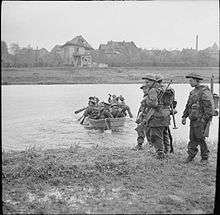157th (Highland Light Infantry) Brigade
| Highland Light Infantry Brigade 157th (Highland Light Infantry) Brigade 157th Infantry Brigade | |
|---|---|
 52nd (Lowland) Division insignia, World War II. | |
| Active |
1908-1919 1920–1947[1] |
| Country |
|
| Branch |
|
| Type | Infantry |
| Role |
Infantry Mountain Air Landing |
| Size | Brigade |
| Part of | 52nd (Lowland) Infantry Division |
| Engagements |
World War I World War II |
The 157th (Highland Light Infantry) Brigade was an infantry brigade of the British Army. The brigade fought in both World War I and World War II, assigned to 52nd (Lowland) Division.
History
Formation
The brigade was originally raised as the Highland Light Infantry Brigade, assigned to the Lowland Division. Both were raised in 1908 when the Territorial Force was created by the amalgamation of the Volunteer Force and the Yeomanry. The brigade was composed of the 5th and 6th (City of Glasgow), 7th (Blythswood) and 9th (Glasgow Highland) battalions of the Highland Light Infantry.
First World War
Upon the outbreak of the First World War in August 1914, the Lowland Division was mobilised immediately for full-time war service. In May 1915 the brigade became the 157th (1/1st Highland Light Infantry) Brigade and the division the 52nd (Lowland) Division. The battalions were also redesignated with the '1/' prefix, 1/4th HLI. This was to avoid confusion with the 2nd Line duplicates which were also forming up and training as the 196th (2/1st Highland Light Infantry) Brigade of 65th (2nd Lowland) Division. The 2nd Line units consisted mainly of those few men who did not volunteer for overseas service when asked at the outbreak of war, together with the many recruits, and were intended to act as a reserve for the 1st Line units being sent overseas. During the war the brigade and division served in the Middle East and later on the Western Front.
Order of battle First World War
- 1/5th (City of Glasgow) Battalion, Highland Light Infantry
- 1/6th (City of Glasgow) Battalion, Highland Light Infantry
- 1/7th (Blythswood) Battalion, Highland Light Infantry
- 1/9th (Glasgow Highlanders) Battalion, Highland Light Infantry (left November 1914)
- 1/5th (Renfrewshire) Battalion, Princess Louise's (Argyll and Sutherland Highlanders) (from April 1915, left 28 June 1918)
- 157th Machine Gun Company (formed 14 March 1916, joined 52nd Battalion, Machine Gun Corps 28 April 1918)
- 157th Trench Mortar Battery (formed 11 June 1917)[2]
Between the wars
After the Great War both the brigade and division were disbanded, as was the rest of the Territorial Force which was later renamed in the 1920s as the Territorial Army and the 52nd Division was reconstituted as was the brigade, which became the 157th (Highland Light Infantry) Infantry Brigade, again composed of the 5th, 6th, 7th and 9th battalions of the Highland Light Infantry and remained this way for most of the inter-war period.[3]
In 1938, due to an increasing need to strengthen the anti-aircraft defences of the country, the 7th Battalion, HLI was transferred to the Royal Artillery and converted into 83rd (7th (Blythswood) Battalion, Highland Light Infantry) Anti-Aircraft Brigade, Royal Artillery.[4] In the same year the 9th (Glasgow Highland) Battalion was redesignated 1st Battalion, Glasgow Highlanders[5] but still retained the Highland Light Infantry as its parent regiment. In the following year the brigade was redesignated as 157th Infantry Brigade.
Second World War

During the Second World War, the brigade served with the division during Operation Ariel in France in mid-1940 to cover the withdrawal of the British Expeditionary Force (BEF) being evacuated from France. In 1942 to June 1944 the division was trained in mountain warfare yet was never used in the role. They were then trained in airlanding operations but were again never utilised in the role. In October 1944 they were sent to Belgium to join the 21st Army Group and were attached to the First Canadian Army and fought in the Battle of the Scheldt. The brigade took part in Operation Blackcock in 1945 and ended the war by the River Elbe.
Order of battle
The 157th Infantry Brigade was constituted as follows during the war:[6]
- 5th Battalion, Highland Light Infantry
- 6th Battalion, Highland Light Infantry (to 12 February 1945)
- 1st Battalion, Glasgow Highlanders (to 12 March 1945)
- 157th Infantry Brigade Anti-Tank Company (formed 12 May 1940, disbanded 7 January 1941)
- 5th Battalion, King's Own Scottish Borderers (from 12 February 1945)
- 7th Battalion, Cameronians (Scottish Rifles) (from 14 March 1945)
Commanders
The following officers commanded the 157th Infantry Brigade during the war:[6]
- Brigadier N.R. Campbell (until 23 April 1940)
- Brigadier Sir J.E. Laurie, Bart (from 23 April 1940 until 30 March 1941)
- Brigadier E. Hakewill Smith (from 30 March 1941 until 22 March 1942)
- Brigadier F.L. Johnston (from 22 March 1942 until 22 November 1943)
- Brigadier F.D. Russell (from 22 November 1943 until 26 January 1945)
- Brigadier E.H.G. Grant (from 26 January until 24 July 1945)
- Lieutenant Colonel (Acting, from 24 July 1945)
References
- ↑ "52nd (Lowland) Infantry Division (1944–45)" (PDF). British Military History. 14 December 2012. Retrieved 28 July 2015.
- ↑ Baker, Chris. "The 52nd (Lowland) Division in 1914-1918". The Long, Long Trail. Retrieved 2 April 2015.
- ↑ "52nd (Lowland) Infantry Division (1930–38)" (PDF). British Military History. 13 December 2009. Retrieved 28 July 2015.
- ↑ "7th Battalion, The Highland Light Infantry [UK]". regiments.org. Archived from the original on 30 December 2005. Retrieved 7 August 2015.
- ↑ "The Glasgow Highlanders [UK]". regiments.org. Archived from the original on 9 February 2006. Retrieved 7 August 2015.
- 1 2 Joslen (1990), p. 344.
Bibliography
- James, Brigadier E. A. (1978). British Regiments 1914–18. London: Samson Books Limited. ISBN 0-906304-03-2.
- Joslen, Lt.-Col. H. F. (1990) [1st. Pub. HMSO:1960]. Orders of Battle, Second World War, 1939–1945. London: London Stamp Exchange. ISBN 0-948130-03-2.